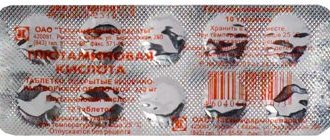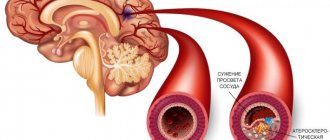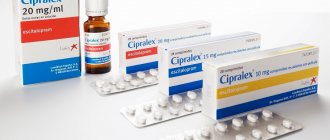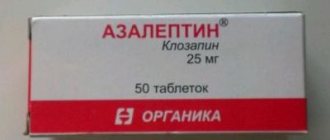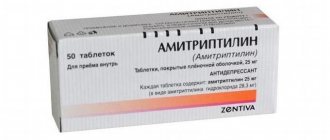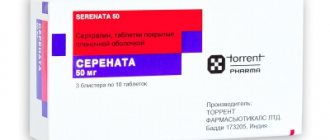Mechanism of action of mood stabilizers
Normotimics belong to the group of psychotropic drugs.
Based on research, the following mechanisms of their impact have been identified:
- decreased neuronal signal transmission;
- suppression of adenylate cyclase concentration;
- activation of the cholinergic system.
Thus, mood stabilizers have the following effects on the body:
- reduce irritability;
- stop impulsiveness;
- reduce temper;
- remove the feeling of hostility towards others;
- normalize the sleep-wake cycle.
Mood stabilizers cause an antimanic effect by exerting a regulatory effect on biological rhythms.
Normotimics (page 1 of 2)
is a group of drugs that differ in their mechanism of action, common to them is their clinical and pharmacological effectiveness, which consists in stabilizing mood. Thanks to this, mood swings in patients with manic states and depression are “evened out”. They are used both for the treatment of affective disorders and for the prevention of relapses and exacerbations (“maintenance”, outpatient therapy) in patients with schizophrenia, manic-depressive psychosis, personality disorders, etc.
Normotimics also have the ability to soften the “sharp angles of character”, irritability, quarrelsomeness, short temper, impulsiveness, dysphoria in patients with various mental disorders.
Lithium preparations, carbazepine derivatives (carbamazepine and oxcarbazepine), valproate, and lamotrigine are used as mood stabilizers. What these drugs have in common is the need for strict medical monitoring of the patient's condition.
Ideally, the concentration of these drugs in the blood should be regularly monitored. Abrupt cessation of taking mood stabilizers can lead to a rapid resumption of affective fluctuations. Taking this into account, the abolition of preventive therapy is carried out gradually, over several weeks.
Drugs with normothimic action include the following:
· Lithium salts (carbonate, gluconate, chloride, citrate, oxybate, long-acting lithium preparations);
· Carbazepine derivatives (carbamazepine);
· Valproic acid (sodium, calcium, magnesium salts).
Mechanism of action
The normothymic effect of this group of drugs is associated with the activation of GABAergic transmission. High doses of carbamazepine and valproic acid, like lithium salts, reduce GABA metabolism by inhibiting GABA transaminase in the hippocampus, basal ganglia and cerebral cortex. The dopaminergic effect is due in part to the fact that GABA is a presynaptic modulator of dopaminergic neurons. Normotimics increase the activity of the cholinergic system. Some drugs affect Na + transport across the membranes of central neurons. The central effect of mood stabilizers is also associated with suppression of adenylate cyclase activation and an effect on benzodiazepine and opiate receptors. This variety of mechanisms of action can explain the wide range of indications for the use of lithium salts and anticonvulsants with normothimic activity.
Normotimic drugs cause a clear antimanic effect; the antidepressant effect during therapeutic and, to a lesser extent, prophylactic use is much less pronounced. According to some data, they all have a regulatory effect on biological rhythms in general, including the circadian rhythm, which, in particular, is manifested by the normalization of the sleep-wake cycle when it is disrupted.
Pharmacokinetics
Regardless of the route of administration, lithium salts quickly dissociate in the body and circulate in the form of ions. Lithium ions are easily absorbed from the gastrointestinal tract. Cmax in the blood after oral administration of lithium carbonate is noted after 1-3 hours. Lithium ions do not bind to proteins and are quickly distributed in the tissues of the body. Lithium ions penetrate most quickly into the kidneys, and slowest into brain tissue. CSF contains on average 2 times less lithium than blood plasma. 95% of the lithium dose is excreted by the kidneys. Although it takes 10-14 days for complete elimination from the body, half the dose is eliminated within 24 hours. The excretion of lithium occurs in proportion to its concentration in the blood plasma, while the b/e part of the lithium ions filtered through the glomeruli is reabsorbed along with sodium ions and water in the proximal convoluted tubules. In the distal convoluted tubules, lithium ions are practically not reabsorbed. Therefore, the renal clearance of lithium is very constant and is about 1/5 of the level of its glomerular filtration. With a negative balance of sodium and water ions, lithium reabsorption also increases. In addition, lithium has its own diuretic (saluretic) effect.
Carbamazepine is slowly absorbed from the gastrointestinal tract, and its peak concentration in the blood is observed only 4-10 hours after administration. T/2 of carbamazepine ranges from 36 to 15 hours (after repeated administration). The concentration of carbamazepine in breast milk is about 25-60% of the drug content in the blood plasma.
Place in therapy
For prophylactic purposes, it is used for phasic affective disorders (psychotic mood disorders).
Side effects
It is customary to distinguish between side effects that occur during adaptation to the drug and develop, as a rule, during the first month of treatment, and side effects that occur in the later stages of therapy, i.e. with long-term prophylactic use. Early side effects usually disappear during treatment, so if they occur, the drug is not discontinued.
Lithium carbon
Early:
Thirst, frequent urination, tremor, nausea, weakness, lethargy, mild lethargy, decreased libido, metallic taste in the mouth, abdominal pain, heartburn, unstable stool;
Late (distant):
Persistent tremor, dysarthria, muscle weakness, lethargy, weight gain, diabetes insipidus. Less common: swelling and symptoms of renal failure, complaints of decreased memory and concentration, decreased libido, diarrhea or constipation, decreased thyroid function (myxedema), heart rhythm disturbances, dermatitis, exacerbation of acne, psoriasis, the phenomenon of “automatic existence,” alopecia , multiple caries, neutrophilia, erythrocytosis.
Carbamazepine
Early:
Drowsiness, impaired eye accommodation, lethargy, ataxia, dizziness, tremor, decreased appetite, nausea, dry mouth, menstrual irregularities;
Late (distant):
Nausea, dry mouth, increased sweating, muscle and headaches, decreased sexual function, liver complaints (allergic hepatitis), allergic dermatitis, increased sensitivity to ultraviolet radiation, leukopenia;
Valproic acid
Early:
Nausea, heartburn, bitterness in the mouth, distorted taste, abdominal pain, weight gain, tremor, alopecia, menstrual irregularities;
Late (distant):
Increased activity of liver enzymes, idiosyncratic hepatitis, loss of appetite, alopecia, abdominal pain, nausea, diarrhea, weight gain, tremor, pancreatitis, thrombocytopenia (increased blood clotting time).
Some of these early side effects may be prolonged. Lithium poisoning usually occurs at plasma concentrations greater than 2.0 mmol/L, although some patients may experience symptoms of toxicity at lower lithium concentrations.
Among the rarer side effects, it should be noted the possibility of developing leukopenia and allergic skin reactions when prescribing carbamazepine, accompanied by painful itching, as well as thrombocytopenia, tremor and ataxia when using valproic acid.
Interaction
If necessary, all mood-timing drugs can be combined with other psychotropic drugs - antipsychotics, antidepressants or tranquilizers. However, in rare cases, unwanted drug interactions may occur, which can be avoided by using lower doses of mood stabilizers.
Lithium salts can enhance the serotonergic effect of antidepressants (especially selective ones) and cause characteristic gastrointestinal and neurological side effects.
Carbamazepine and valproic acid are strong inducers of liver enzyme activity that can affect the metabolism of many drugs, reducing their effectiveness or increasing the risk of developing toxic effects.
It is necessary to exclude the combined use of MAO inhibitors with carbamazepine or lithium salts with diuretics (except osmotic and carbonic anhydrase inhibitors).
Blockers of slow calcium channels can increase the level of carbamazepine in the blood plasma by 30-50%. Macrolide antibiotics and isoniazid have almost the same effect.
Carbamazepine increases the metabolism of glucocorticoids and therefore may give a false-positive reaction to the dexamethasone test.
Carbamazepine reduces the effectiveness of oral contraceptives, reduces the blood concentration of theophylline, indirect anticoagulants, and anticonvulsants (including valproic acid and phenytoin).
Carbamazepine enhances the metabolism of imipramine. Due to drug interactions, the risk of developing toxic effects or unexpected paradoxical reactions may increase (for example, when carbamazepine is combined with fluoxetine or anesthetics). The combined use of calcium channel blockers with lithium salts should be avoided due to a dangerous increase in side effects (nausea, ataxia, muscle twitching and other toxic effects). In addition, when used together with carbamazepine, the content of the latter in the blood plasma increases, which can lead to the development of toxic reactions.
Valproic acid doubles the content of the free fraction of diazepam and some other benzodiazepines in the blood, but does not affect the metabolism of clonazepam.
Fluoxetine, chlorpromazine and especially acetylsalicylic acid slow down the metabolism of valproic acid and increase the content of the free fraction in the blood.
Valproic acid may reduce the metabolism of other anticonvulsants (ethosuximide, phenytoin).
Literature
1. Bochanova E.V. and others. Psychosomatic diseases: a complete reference book / ed. Yu.Yu. Eliseeva. - M.: Eksmo, 2003. – 605
2. https://www.drpsy.ru/farmakoterapiya/normotimiki.html
Indications for use and classification
The general goal of mood stabilizers is to normalize mood. They are actively used in psychiatry and prescribed for the treatment of affective disorders.
These include:
- schizophrenia;
- affective insanity;
- prolonged recurrent depression;
- cyclothymia.
Often, mood stabilizers are prescribed for mental disorders if the disease is accompanied by irascibility, impulsivity, irritability and aggression. They are able to smooth out such manifestations.
Normotimics are classified into the following categories:
- Lithium preparations . Used to treat manic states. They normalize mental balance and the function of sodium channels.
- Carbamazepine derivatives . They are used for exacerbation of affective states more than four times a year, depression, mania, and schizophrenia.
- Lamotrigine and drugs based on it . Initially created for patients with epilepsy. They have side effects such as allergies, damage to the nervous system, and intestinal disorders.
- Valproate . Prescribed for bipolar disorder and chronic low mood. Drugs in this group inhibit neurotransmitters.
Sometimes mood stabilizers are prescribed for infrequent relapses of psychosis.
List of drugs
There are many mood stabilizers sold through the pharmacy chain, which differ in the main active ingredient. Let's look at some drugs, a list of the best of them is presented below.
- Valparin
Used for the treatment of epilepsy of various origins, in the complex therapy of manic-depressive states. Tablets are taken two to three times a day during or after meals. During therapy, alcoholic drinks are prohibited and a diet is recommended due to the risk of weight gain.
- Convulex
Indications for use of Konvulex: organic brain diseases, behavioral disorders, febrile seizures. The dosage is prescribed individually for each patient. Usually 10-15 mg per kilogram of weight per day is prescribed, followed by an increase. Frequency of administration: two to three times a day. Side effects from the digestive system are possible in the form of diarrhea, nausea, constipation.
- Convulsofin-retard
A popular drug for the treatment and prevention of bipolar disorders is based on valproic acid. It is prohibited for children under six years of age to take it. The average daily dose for an adult is 20 mg per day per kilogram of body weight.
- Actinerval
Normotimik is used to prevent attacks in alcohol withdrawal syndrome and affective psychoses. The doctor determines the frequency of administration individually. The starting dose for adults is 100 to 400 mg.
- Zeptol
The active substance is carbamazepine. Zeptol is taken 200 mg twice a day with a gradual increase in dosage. The duration of the course is determined by the attending doctor. Contraindicated in children under 5 years of age.
- Finlepsin
The tablets have antipsychotic, antiepileptic and analgesic effects. It is used to relieve seizures of various origins and treat mental disorders that are accompanied by increased anxiety. Initial and maintenance dosage is from 200 to 400 mg per day.
- Seroquel
It is an antipsychotic drug that is recommended for acute and chronic psychoses, including schizophrenia. The active ingredient is quetiapine. The dosage of Seroquel, as a mood stabilizer, is 50 mg per day in adults and 25 mg for older people. Afterwards the quantity is increased according to the scheme. The exact dosage is calculated based on the clinical effect and individual sensitivity of the patient.
Some of the drugs on this list are not available without a doctor's prescription. For example, Seroquel, Convulex.
Thymoisoleptics are mood stabilizers of a new generation. They are considered more effective means. Thymoisoleptics reduce the risk of remission and provide a positive effect in a short time. They are not addictive and do not lead to the development of depression. These include:
- Cyclodol
An antiparkinsonian drug helps eliminate movement disorders. The initial dose is from 0.5 to 1 mg per day. Side effects from the central nervous system are possible in the form of headaches and irritability.
- Lithium carbonate
Lithium carbonate is used for manic episodes, hypomania, alcohol dependence syndrome and other mental problems. The drug is not compatible with ethanol-containing drinks. In combination with antipsychotics and antidepressants, body weight may increase. The dosage is prescribed based on the concentration of lithium in the blood. Typically it ranges from 900 to 2400 mg per dose. The dose is divided into 3-4 doses.
- Lamotrigine
The antiepileptic drug Lamotrigine inhibits the release of glutamic acid. It is prescribed for the treatment of seizures in Lennox-Gastaut syndrome, as a prophylactic drug for depression and various manias. The daily dosage ranges from 100 to 200 mg.
Types of mood stabilizers[edit | edit code]
Mineral salts[edit | edit code]
- Lithium preparations
- Rubidium chloride[1]
- Cesium chloride[1]
Anticonvulsants with normothimic activity[edit | edit code]
- Carbamazepine
- Oxcarbazepine
- Valproic acid
- Lamotrigine
- Gabapentin
- Levetiracetam [2]
Atypical antipsychotics[edit | edit code]
- Aripiprazole
- Asenapine
- Risperidone
- Olanzapine
- Quetiapine
- Clozapine
Calcium antagonists[edit | edit code]
- Verapamil[3]
- Nifedipine[4]
- Nimodipine[5][6]
Thyroid hormones[edit | edit code]
Thyroid hormones may also be used as adjunctive therapy, especially when antidepressants are temporarily discontinued.
- Triiodothyronine[7]
- L-thyroxine[8]
Side effects
It is important to carry out treatment with mood stabilizers under medical supervision and periodically check the level of the substance in the blood fluid.
To do this, they monitor the general condition of the patient’s body and donate blood for biochemistry and urine for clinical analysis every four weeks.
If you exceed the dosage of drugs, the side effects of mood stabilizers will worsen.
complications may occur when treated with lithium salts . Similar effects appear during the period of adaptation to the medication and in the last stages of therapy.
In the first 1-2 weeks, the patient is bothered by the following symptoms:
- muscle weakness;
- thirst;
- tremor of the limbs;
- drowsiness;
- feeling of nausea;
- rarely vomiting;
- loss of appetite.
These phenomena do not require correction of the treatment regimen. Usually the daily dose is divided into a larger number of doses.
Late side effects include:
- neurological and somatic disorders;
- motor retardation;
- decreased performance.
People who have the following pathologies should take mood stabilizers with caution:
- blood diseases;
- bone marrow pathologies;
- serious kidney and liver diseases;
- heart rhythm failure;
- acute pancreatitis;
- BPH;
- low pressure.
Pregnant girls and nursing mothers should not start taking medications.
Thanks to mood stabilizers, it is possible to safely and quickly return the patient to a normal lifestyle. Before starting therapy, you should consult with a neurologist and psychiatrist and study contraindications.

